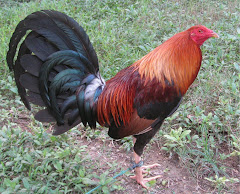


Selected portions of
COCKFIGHTING IN BALI
By Fred B. Eiseman, Jr.
Written Especially For Wasantara-Net
So popular has cockfighting been in Bali for so many decades, that it is about as realistic to tell a Balinese man that he cannot participate in his favorite sport as it is to tell the sun not to rise.
RELIGION
Cockfights have one other aspect, the religious, that is not well-appreciated by visitors to Bali. One important characteristic of the Balinese Hindu religion is the making of offerings. This is a complex subject that requires here a broad, sweeping generalization. One important function of offerings is as a means of communications between man and the gods. Higher deities are given offerings that emphasize the beautiful and tasteful side of life - flowers, fruits, leaves, and the like, usually placed in containers of young coconut leaf that are cut to various degrees of intricacy. These offerings are normally placed in elevated shrines or niches, befitting the belief that these deities have physical as well as spiritual elevation.
No less important is a class of spirits that are impish, lustful, impetuous, greedy, unpredictable, and capable of causing harm to those who interfere with them. These lower spirits that live on or near the ground have a variety of names and characteristics. In my village they are called butakala. It is wrong to think of them as being evil spirits. As with all spirits they are ambivalent; their behavior toward man is a function of how they are treated. They are just as capable of helping and protecting their human neighbors as they are of causing sickness, accidents, or the loss of a prized possession. If they are treated with respect, according to well known principles, they can be kept under control, and, indeed, they can be depended upon for protection.
Butakala are more animal-like than the higher spirits and require considerable amounts of food in the form of offerings. Ceremonies that are principally directed toward butakala always require an animal sacrifice, which may range from a small chick to a water buffalo, depending upon the size and importance of the occasion. One of the most important requirements
of butakala is a blood sacrifice that must be poured upon the ground.
This is where cockfights come in. Whenever there is an important Balinese Hindu ceremony, there should be a blood sacrifice made to the local butakala to win their cooperation and support. Such a ceremony might range from a rite of passage, to the anniversary celebration of a temple or shrine, to the purification of an area that is known to be adversely affected by butakala. At such a time a cockfight is legal, and, in fact, a requirement. The local cockfighters come in from the cold, so to speak, and do their thing right out in public - perhaps even inside a public temple. The losing cock contributes his blood to the butakala, and all is well.
Theoretically only three rounds of such a religious cockfight are legally permitted. But, things being as they are, the normal procedure is to retire to the local wantilan and continue, sometimes all day long. The police won't bother such an event since it is held under the guise of religion.
HANDICRAFT INDUSTRY
Cockfighting supports a considerable handicraft industry. The most obvious necessities are the big, beehive-shaped cock baskets woven in a hexagonal pattern from bamboo strips. Every road is lined with rows of these cages, called guungan siap. They are shifted regularly to give the inhabitants thereof the proper balance of light and shade. The idea of placing them near a road is to get the cocks accustomed to noise, people, and activity, so that, when put into action in the arena, they will not be afraid of the spectators and noise and run away. Hanging on the outside of the cage is a half coconut shell from which the
cock is fed his special mixture of food and from which he is watered frequently. There are several villages in Bali in which the chief industry, next to farming, is making cock baskets.
These baskets are too big to be used for carrying a cock to the fight on a motorbike or on foot, so there is a brisk trade in smaller, purse-like, portable baskets with carrying string that can be slung over the shoulder, or with handles that allow them to be carried like a shopping bag.
There are craftsmen who specialize in making the sharp steel spurs, called taji, that are tied on the cock's leg before the fight. In the old days broken automobile springs were the raw material, and the blades were straight and shaped like stilettos. Nowadays many smiths use pieces cut from hard, tough, industrial-size hacksaw blades. There are others whose specialty is sharpening the blades and removing the nicks from previous encounters.
It is difficult to penetrate the shell of many cultures. The adjective inscrutable has been overworked in the case of Asia, but it is apt. Fear of misunderstanding and ridicule, desire to maintain privacy, and unwillingness to risk profanation of the sacred have required some groups to erect formidable barriers that prevent perforation by the casual observer. But, every now and then one finds an opening, a cultural crack through which a glimpse of the interior is possible.
Such cracks often occur in connection with public events that are so popular and are participated in with such vigor and enthusiasm that, for the time being, the protective reserve and dignity and politeness shown to foreigners are forgotten, and the real values and character of the people hang out, so to speak, for everyone to see.
Fighting cocks, cockfighting, and wagering on the fights have been popular obsessions with the Balinese for generations. The tourist who can worm his way into the sweating, jostling, noisy, gesticulating crowd of men and join them, standing around an open arena, watching the proceedings, might wonder if he has stepped into a different country. Are these the graceful, deferential, dignified people whom he has seen in his hotel? Are these the same individuals who carry the offerings to the temples and pray with such lovely and heart-felt fervor? There is no better place than the cockfight to observe Balinese values and behavior. But, the casual observer is likely to focus his attention on the brief cockfight itself. This is understandable. The boisterous crowd itself is a sight to behold. As it suddenly quieted down and the action began, the fast and furious flurries of engagement are punctuated with the ohhhh's, and ahhhh's of the audience. The impressions of color and primeval combat were blurs of color. and suddenly it is over, and the tourist leaves.
But, if that is the only impression, the visitor misses most of the significance. The preliminaries and the post script, the daily treatment of the fighting cocks, the arcane lore of the sport, and especially the intricacies of the betting are as integral a part of the story as the fight itself. And, unfortunately, they are aspects that most people miss because they occur in such a seemingly chaotic fashion as to make them unintelligible to anyone but the person who would take the time and trouble to investigate.








